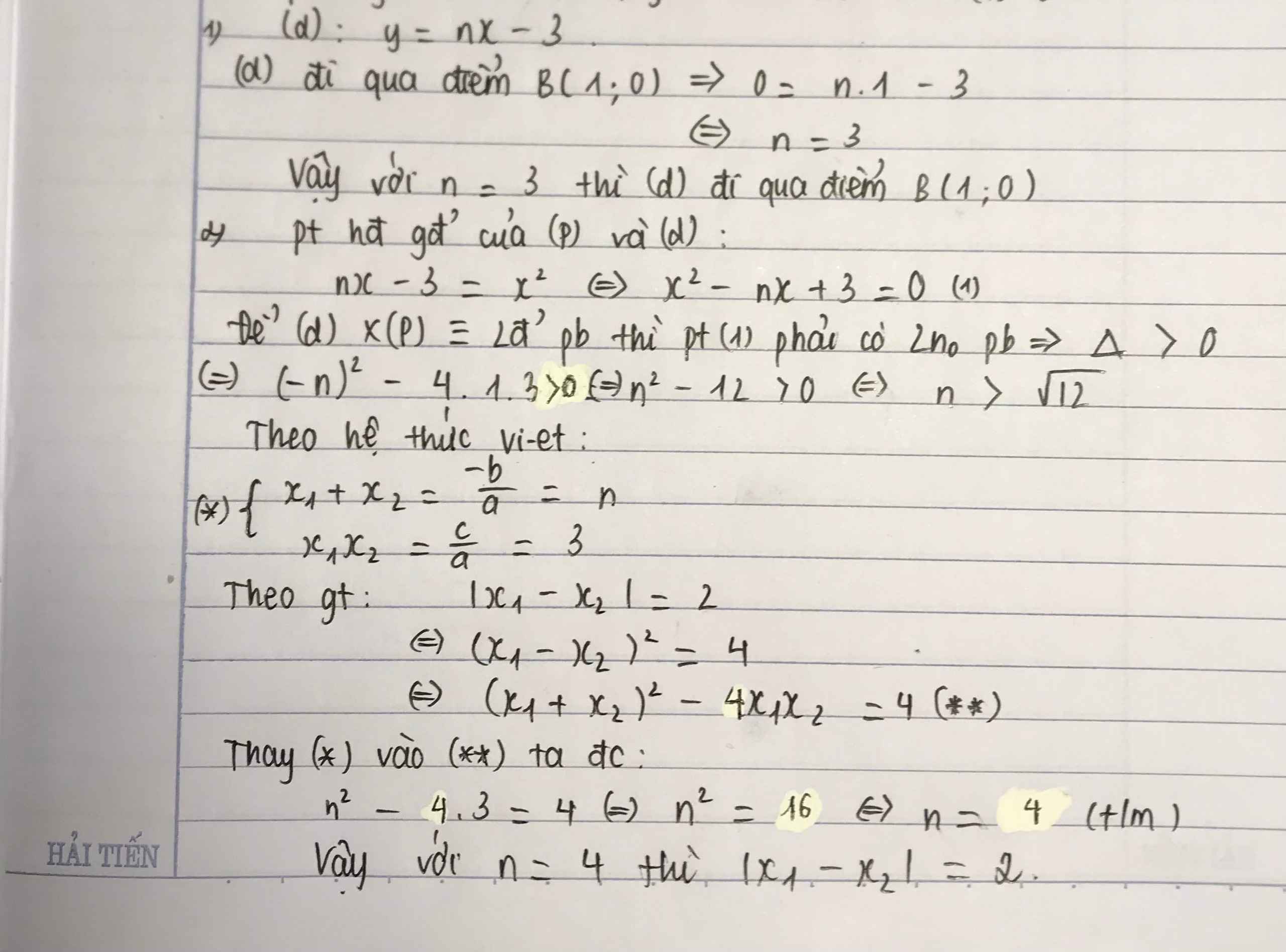Hãy nhập câu hỏi của bạn vào đây, nếu là tài khoản VIP, bạn sẽ được ưu tiên trả lời.

a (tóm tắt lại): Phương trình hoành độ giao điểm của (P) và (d):
\(x^2=mx-m+1\)
\(\Leftrightarrow x^2-mx+m-1=0\left(1\right)\)
Để (d) cắt (P) tại 2 điểm phân biệt thì phương trình (1) phải có 2 nghiệm phân biệt. Do đó \(\Delta>0\Leftrightarrow m\ne2\).
b) \(\left(1\right)\Leftrightarrow\left(x-1\right)\left(x+1\right)-m\left(x-1\right)=0\)
\(\Leftrightarrow\left(x-1\right)\left(x-m+1\right)=0\)
\(\Leftrightarrow\left[{}\begin{matrix}x=1\\x=m-1\end{matrix}\right.\)
Do đó phương trình (1) có 2 nghiệm là x=1 và x=m-1. Mặt khác phương trình (1) cũng có 2 nghiệm phân biệt là x1, x2 và vai trò của x1, x2 trong biểu thức A là như nhau nên ta giả sử \(x_1=1;x_2=m-1\left(m\ne2\right)\)
Từ đây ta có:
\(A=\dfrac{2.1.\left(m-1\right)}{1^2+\left(m-1\right)^2+2\left[1+1.\left(m-1\right)\right]}\)
\(=\dfrac{2\left(m-1\right)}{1+\left(m-1\right)^2+2+2\left(m-1\right)}\)
\(=\dfrac{2\left(m-1\right)}{1+\left(m^2-2m+1\right)+2+2m-2}=2.\dfrac{m-1}{m^2+2}\)
\(\Rightarrow A\left(m^2+2\right)=2\left(m-1\right)\)
\(\Leftrightarrow Am^2-2m+2\left(A+1\right)=0\left(2\right)\)
Coi phương trình (2) là phương trình bậc 2 tham số A ẩn x, ta có:
\(\Delta'\left(2\right)=1^2-2A\left(A+1\right)=-2\left(A^2+A\right)+1=-2\left(A+\dfrac{1}{2}\right)^2+\dfrac{3}{2}\)
Để phương trình (2) có nghiệm thì \(\Delta'\left(2\right)\ge0\Rightarrow-2\left(A+\dfrac{1}{2}\right)^2+\dfrac{3}{2}\ge0\)
\(\Leftrightarrow\left(A+\dfrac{1}{2}\right)^2\le\dfrac{3}{4}\)
\(\Leftrightarrow-\dfrac{\sqrt{3}}{2}\le A+\dfrac{1}{2}\le\dfrac{\sqrt{3}}{2}\)
\(\Leftrightarrow-\dfrac{\sqrt{3}+1}{2}\le A\le\dfrac{\sqrt{3}-1}{2}\)
Để phương trình (2) có nghiệm kép thì: \(\Delta'\left(2\right)=0\Rightarrow m=\dfrac{1}{A}\)
\(MinA=-\dfrac{\sqrt{3}+1}{2}\Leftrightarrow\Delta'\left(2\right)=0\Leftrightarrow m=\dfrac{1}{A}\dfrac{1}{-\dfrac{\sqrt{3}+1}{2}}=1-\sqrt{3}\)
\(MaxA=\dfrac{\sqrt{3}-1}{2}\Leftrightarrow\Delta'\left(2\right)=0\Leftrightarrow m=\dfrac{1}{A}=\dfrac{1}{\dfrac{\sqrt{3}-1}{2}}=\sqrt{3}+1\)
Mình mới sửa một chút nhé.
\(\left(A+\dfrac{1}{2}\right)^2\le\dfrac{3}{4}\) \(\Leftrightarrow\left|A+\dfrac{1}{2}\right|\le\dfrac{\sqrt{3}}{2}\Leftrightarrow\left[{}\begin{matrix}A+\dfrac{1}{2}\le\dfrac{\sqrt{3}}{2}\\A+\dfrac{1}{2}\ge\dfrac{-\sqrt{3}}{2}\end{matrix}\right.\Leftrightarrow\dfrac{-\sqrt{3}}{2}\le A+\dfrac{1}{2}\le\dfrac{\sqrt{3}}{2}\)
Nếu gặp dạng \(a^2\le b\) (b là số dương) thì a sẽ bé hơn b và lớn hơn số đối của b, nói chung a nằm trong khoảng từ -b đến b.
Ví dụ: \(a^2\le4\Leftrightarrow\left|a\right|\le2\Leftrightarrow-2\le a\le2\)

Phương trình hoành độ giao điểm của (P) và (d) là :
\(x^2=2\left(m+3\right)x-m^2-3.\)
\(\Leftrightarrow x^2-2\left(m+3\right)x+m^2+3=0\left(1\right)\)
\(\Delta'=[-\left(m+3\right)]^2-m^2-3=m^2+6m+9-m^2-3=6m+6\)
Để (d) cắt (P) tại hai điểm phân biệt có hoành độ x1 ; x2 thì phương trình (1) có hai nghiệm phân biệt x1 x2.
\(\Rightarrow\Delta'>0\Leftrightarrow6m+6>0\Leftrightarrow m>-1\)
Theo vi ét ta có:
\(\hept{\begin{cases}x_1+x_2=2\left(m+3\right)\\x_1x_2=m^2+3\end{cases}}\)
Thay vào hệ thức : \(x_1+x_2-\frac{x_1x_2}{x_1+x_2}=\frac{57}{4}\)ta được.
\(2\left(m+3\right)-\frac{m^2+3}{2\left(m+3\right)}=\frac{57}{4}\Leftrightarrow\frac{4\left(m+3\right)^2-m^2-3}{2\left(m+3\right)}=\frac{57}{4}\)
\(\Leftrightarrow\frac{4m^2+24m+36-m^2-3}{2m+6}=\frac{57}{4}\Leftrightarrow\frac{3m^2+24m+33}{2m+6}=\frac{57}{4}\)
\(\Leftrightarrow12m^2+96m+132=114m+342\)\(\Leftrightarrow12m^2-18m-210=0\Leftrightarrow2m^2-3m-35=0\)
\(m_1=5\left(TM\right);m_2=-\frac{7}{2}\left(KTM\right)\)
Vậy \(m=5\).

Phương trình hoành độ giao điểm:
\(x^2-\left(2m+1\right)x+m^2+m-6=0\left(1\right)\)
Ta có:
\(\Delta=\left(2m+1\right)^2-4\left(m^2+m-6\right)=25>0\forall m\)
\(\Rightarrow\) Phương trình (1) luôn có hai nghiệm phân biệt.
Theo định lí Vi-et \(\left\{{}\begin{matrix}x_1+x_2=2m+1\\x_1x_2=m^2+m-6\end{matrix}\right.\)
\(\Rightarrow\left(x_1-x_2\right)^2=\left(x_1+x_2\right)^2-4x_1x_2=\left(2m+1\right)^2-4\left(m^2+m-6\right)=25\)
\(\Rightarrow\left|x_1-x_2\right|=5\)
Lại có:
\(x_1^2+x_2^2+x_1x_2=\left(x_1+x_2\right)^2-x_1x_2=\left(2m+1\right)^2-\left(m^2+m-6\right)=3m^2+3m+7\)
Khi đó \(\left|x_1^3-x_2^3\right|=50\)
\(\Leftrightarrow\left|x_1-x_2\right|\left(x_1^2+x_2^2+x_1x_2\right)=50\)
\(\Leftrightarrow5\left(3m^2+3m+7\right)=50\)
\(\Leftrightarrow m^2+m-1=0\)
\(\Leftrightarrow m=\dfrac{-1\pm\sqrt{5}}{2}\)



1) Thay x=0;y=1 vào (d)=>m=2
Hoành độ giao điểm là nghiệm của phương trình:\(x^2=x+m-1\)
\(x^2-x-m+1=0\)2 điểm phân biệt => \(\Delta>0\)
\(\Delta>0=>1-4.\left(-m+1\right)=4m-3>0=>m>\frac{3}{4}\)
Áp dụng hệ thức Vi-ét:
\(x_1+x_2=1;x_1x_2=-m+1\)
\(4.\left(\frac{1}{x_1}+\frac{1}{x_2}\right)-x_1x_2+3=0=>4.\left(\frac{x_1+x_2}{x_1x_2}\right)-x_1x_2+3=0\)
\(\Rightarrow\frac{4}{-m+1}+m-1+3=0=>\frac{4}{-m+1}+m-2=0=>m^2-3m-2=0\)
Dùng công thức nghiệm được \(\Rightarrow x_1=\frac{3-\sqrt{17}}{2}\left(KTM\right);x_2=\frac{3+\sqrt{17}}{2}\left(TM\right)\)
Vậy...